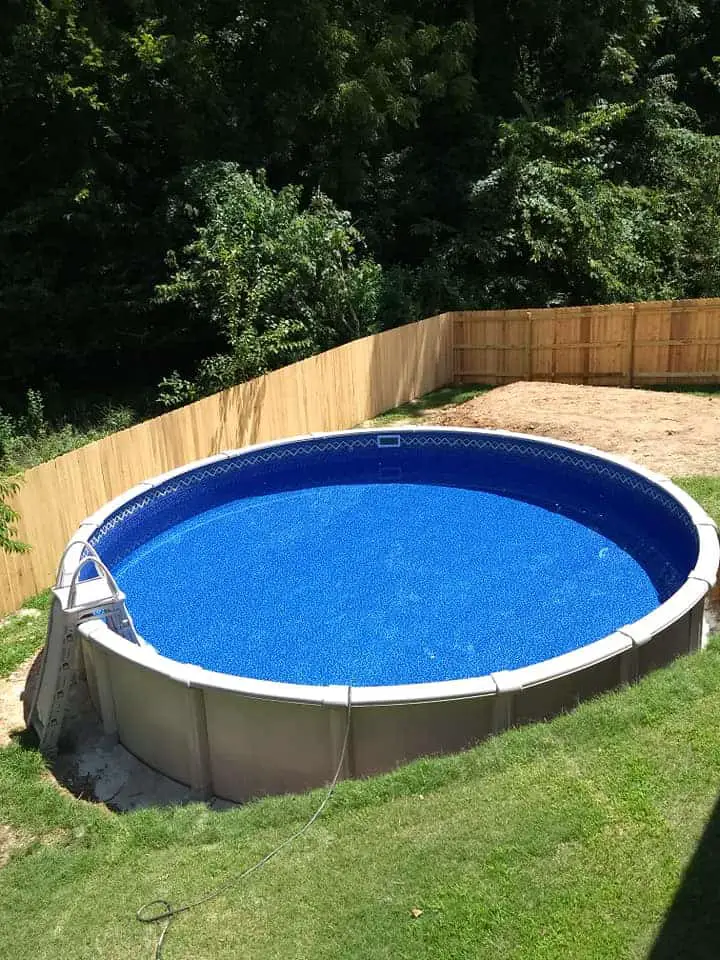
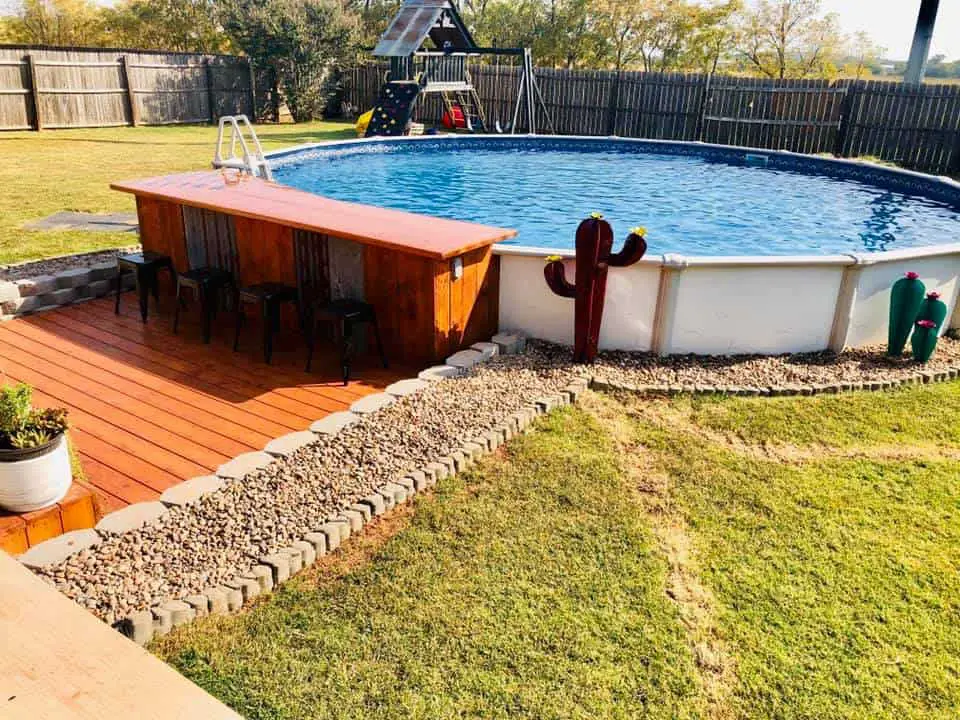

In the past maybe ten years, future pool owners have been asking about sinking an above ground swimming pool in the ground more and more. And here in Florida, it’s no wonder as the prices for inground pools have gone up to an average of over fifty thousand dollars. Yikes!
You can sink or bury an above ground pool in the ground about half-way with few issues. Going deeper than that requires some precautionary measures.
CAN YOU SINK ANY ABOVE GROUND SWIMMING POOL IN THE GROUND?
The answer to this now very common question is an enthusiastic “yes”. There are a few things you may want to know about it though.
First off, they don’t call it an “above ground” pool because it just sounds good. This is a product that is, in fact, designed to go on top of the ground and not in it. That is not to say that you shouldn’t put it in the ground some or that it won’t do well in the ground.
This is just a good starting point for understanding that there are limitations. Some have the mentality that by burying an above ground pool, they can get the same thing as an in-ground for a fraction of the money. Yeah, no. But you can have something really, really nice when you’re done.
THE TERM “SEMI-INGROUND” CAN MEAN TWO DIFFERENT THINGS
The vast majority of pools that are called “semi-inground” are just above-ground swimming pools that can go partially in the ground. In truth, ALL metal walled above ground pools can go halfway in the ground. Soft-sided pools can too, but it’s not advised. Semi-inground is a term above ground pool retailers use for people looking to put a pool in the ground some.
There is a type of pool that is truly a semi-inground. They have different walls to them which are thicker and always made of aluminum. An above-ground pool has a continuous roll wall(one piece). A true semi-inground has a slatted wall that comes in sections that are hooked together.
True semi-inground pools cost more than regular above ground pools. A lot more! Two examples of true semi-inground pools are the Oasis by Wilbar and the Aquasport by Buster Crabbe.
Sinking an above ground pool partially in the ground is fine, but there are some things to consider as they are designed to go on top of the ground. Sinking a true semi-inground pool is less problematic because it’s designed to go in the ground. If you are willing to pay thousands more for the same end result, or if you are wanting something that will last decades, go with a true semi-inground.
If you are want to have a pool somewhat in the ground and are on a budget, go with an above ground pool partially in the ground.
11 THINGS TO KNOW ABOUT SINKING AN ABOVE GROUND POOL PARTIALLY IN THE GROUND
1. It could potentially cave-in years later when it’s time to change the liner

This is by far the biggest concern in burying an above ground pool. When an AG pool is in the ground and full of water, then nothing can really happen to it. The water in the pool creates an outward pressure that disallows the surrounding earth to misshape or cave it in.
The danger of a cave-in is only when the pool is empty(no water in it). At that point, the surrounding earth can push or fall against the pool’s wall and cause it to cave inward. This can result in a range from a simple denting in a small area of the wall that can be easily fixed, all the way to the pool’s wall caving in all the way around and completely destroying it.
The good news here is that you should only drain an above ground swimming pool when it’s time to change the liner. And that’s because liners will immediately begin to shrink when the pool doesn’t have water in it. If the pool stays empty for more than an hour or so, the liner could shrink enough to pull down off the wall when you re-fill. This would result in needing a new liner.
The further down in the ground you go, the more likely to have a cave-in issue at liner change time. I recommend burying an above ground pool only half-way or less. This will lessen your chances of having an issue later.
2. Sinking an above ground pool partially in the ground will NOT cause any premature or added rust/corrosion
When it comes to rust, people have all kinds of opinions. And when their pool gets rust, they are quick to blame things that may or may not have anything to do with it. A pool being partially in the ground is usually a quick blame for why a pool got rust. And in most cases, that had nothing to do with the corrosion.
I have installed and worked on above ground swimming pools for 34 years. I have seen thousands of pools partially(and some fully) in the ground and I have seen thousands of pools that got rust. In all that time, I have not been able to link rust or corrosion with a pool being in the ground at all.
I know common sense will tell some that something metal being in the ground will cause it to corrode(rust) and if I didn’t know better, I would make the same conclusion with that same logic. My extensive and long-term observation suggests otherwise though.
In Central Florida (where I have installed most of my over 5,000 pools), there are areas that are and stay very wet, and there are good “high and dry” areas. I have seen pools partially in the ground at every moisture level. Some have rusted quickly and some never got a speck of rust. And that variation had nothing to do with how wet the earth was or stayed.
In truth, I or no one else really knows why some pools rust. Sometimes it very apparent and sometimes I can’t even guess. I can say though, that an above ground pool being partially in the ground usually has nothing to do with it rusting.
3. The hole must be bigger than the size of the pool
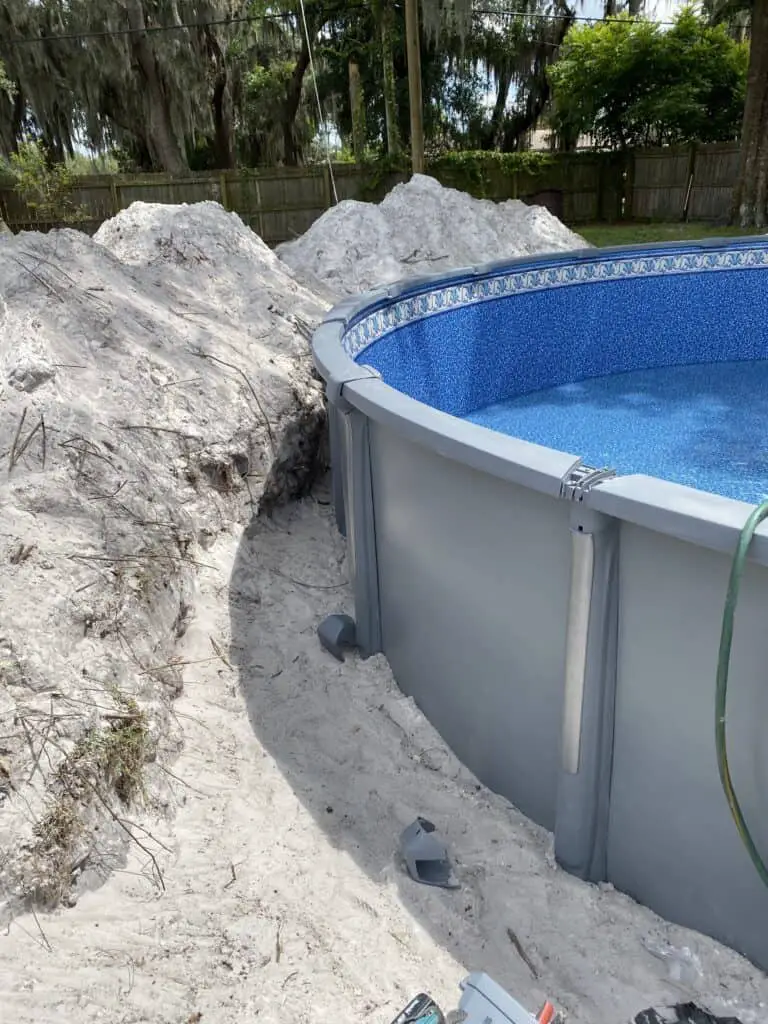
This may sound like I’m being captain obvious, but you might be surprised at the number of future pool owners who don’t consider this. I guess they think I can assemble the pool somewhere else and just drop the pool in the same sized hole with a helicopter or something.
The pool has to be assembled in the hole. And that takes added room. When I build a pool on top of the ground, I level an area one foot bigger all the way around. As an example, if building a 24’ round pool on top of the ground, I level a 26’ circle.
If I’m installing that same 24’ round pool in the ground two feet down, I’ll need that area to be a leveled 27’ circle. I need that extra foot of space so I have room to build the pool.
As a general rule then, if you are burying a pool 2’ deep in the ground, make the hole three feet bigger than the size of the pool. NOTE: For oval pools, keep in mind that you have to make extra space for the buttresses (even if it’s called a “buttress-free” pool). Here’s a chart for some common pool sizes:
Hole dimensions for sinking a pool 2-2.5ft in the ground
12’ round pool 15’ hole
15’ round pool. 18’ hole
18’ round pool. 21’ hole
21’ round pool. 24’ hole
24’ round pool. 27’ hole
27’ round pool. 30’ hole
30’ round pool 33’ hole
12×24 oval pool 27’x 20’ oval hole
15×24 oval pool. 27’x 23’ oval hole
15×26 oval pool. 29’ x 23’ oval hole
15×30 oval pool. 33’x 23’ oval hole
18×33 oval pool. 36’ x 26’ oval hole
21×42 oval pool. 45’ x 29’ oval hole
*Oval models have different length buttresses. Check the installation manual for actual dimensions of the footprint and add 3’ to that.
4. Sinking an above ground pool makes the job much bigger

When an above ground pool is installed on the ground, it’s not too big of a job. There will be some sod that will have to be removed from the install site to be dealt with, and there may be some roots or rocks, but that’s about it.
When sinking a pool in the ground though, it can affect the entire yard. Not only is there the taken up grass, there’s also tons of removed earth to deal with. You may have to haul it away or pile it up somewhere or distribute it throughout the yard. Either way, it makes a mess.
Some above ground pool installers don’t use a machine when installing on top of the ground. When going in the ground though, there will be a machine involved. This could mean having to make access for it by removing fence sections and/or moving or disturbing some landscaping. And there will be some grass damage from the wheels or tracks of the machine, especially if they are hauling dirt away.
There is also backfilling that has to happen when a pool goes in the ground. Backfilling has to happen after the pool is filled with water, so that will happen another day which certainly adds to the job.
Some will choose to build a retaining wall around their dug hole. That adds to the job of getting a pool, and it will add to the price too.
5 The pump must be set lower than the pool’s water level
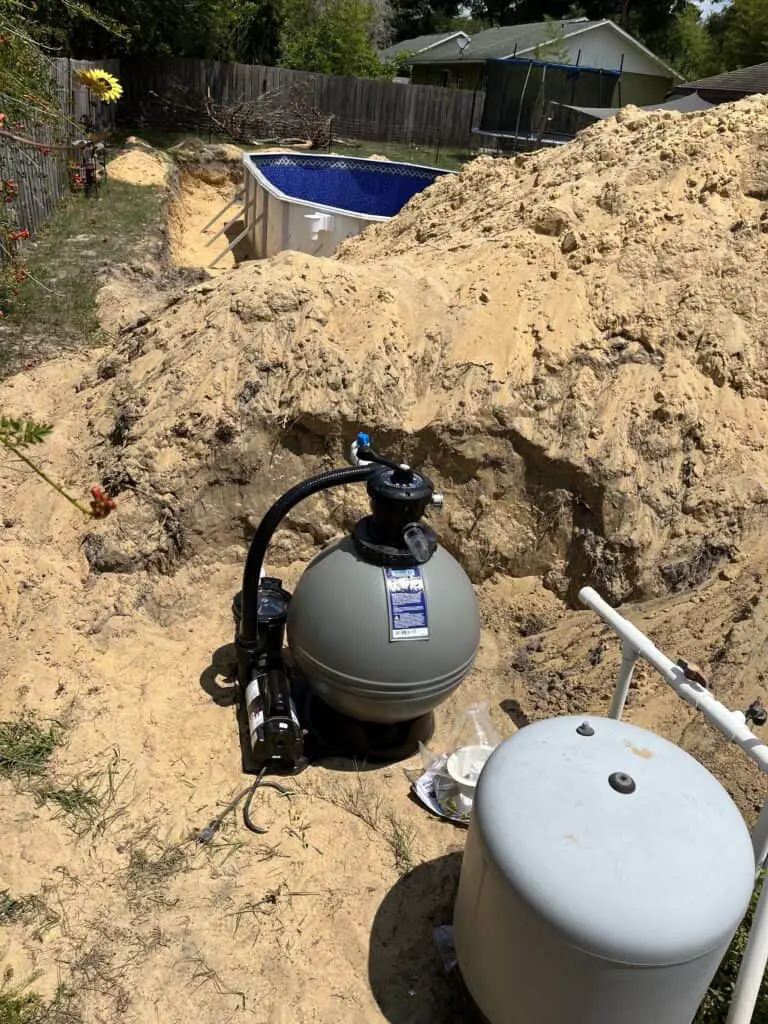
Most above ground pool pumps are only gravity fed-type. This means that they cannot draw water up and therefore must be placed below the water level of the pool in order to work properly.
This is another reason that I recommend only going in the ground 2.5ft max. This will allow you to set the pump at ground level. Having to set the pool equipment in a hole because the pool is too low in the ground is not ideal.
6. The added cost of sinking an above ground pool
Digging a hole requires a machine. And excavators aren’t cheap. They aren’t cheap to own or rent.
Some decide to rent a machine and dig the hole themselves. That can be fun if your yard is bigger and you have some experience with construction. If it’s a tight spot to dig in or if you’ve never been on a machine before, it’s gonna be more stressful than fun.
Expect to pay about $350 to rent the correct excavator for the half or full day you will need to dig the hole.
If you are going to pay someone to dig the hole, it would be best if the installer to dig it. This is if he has a machine. A lot of installers don’t have machines but may rent one when they need to do digs. The other option is to have an excavator come to dig the hole first and then the installer builds the pool later.
The cost to have a hole dug 2’ down will depend greatly on where you live and what your earth is made of. In Central Florida, the earth is mostly sand, so the dig cost is much less. Clay is much harder to dig and rocks or even harder.
When I was selling pools online, I had a customer that lived in Arizona who wanted their pool to go one foot down. Their earth was mostly rock, so they had to jack-hammer out the hole. That was pricey.
Just to give you an idea of what it will cost, for a 24’ round pool going down 2’, I charge about $1000 to dig the hole. That does not include hauling any dirt away or any backfilling. My price isn’t the cheapest. I’d say it’s an average price to dig a 27’ round hole(for a 24’ pool) two feet down in a back yard.
Some will choose to build a retaining wall around the buried part of their above ground pool. This is usually not needed, but if it is, it’s an expensive addition to the project.
Backfilling isn’t too big of a job, but it has to be done another day as the pool needs to have water in it beforehand. Excavators will leave piles of dirt around the hole, so the backfilling (putting dirt back around the pool) is easier as the dirt is right there. Most pool owners will elect to do the backfilling themselves, but if you don’t, expect to pay $200 – $300 for the installer to come back and do that.
7. When digging down, you may run into something
There is no telling what might be in the earth. Last month, I was doing a one foot down dig for a 27’ pool. At about ten inches down, I ran into a tree stump that was there before the house was built. It was too big to do anything with, so we had to move the pool location over about three feet from where they wanted it.
When going into the earth, you can run into things that will change the location or how deep you can go down. I have run into electrical lines (mostly not to code), water mains, old dump sites for trash, huge boulders, and old concrete structures. They all caused the job to change in some way.

The most common issue I run into when digging a hole for an above ground pool is hitting water. It’s hard to determine what the water table is in any given area or yard. Most areas are OK, but if you live in a low or wet area, don’t be surprised if you run into water.
Of course, if anything is in question, locate all power, gas, and water lines before you dig. Keep in mind that you, the landowner is responsible for what’s in the ground. This is a general rule regardless of whatever a contract says. If anything is in question around where you want the pool hole dug, investigate and locate first. That way, you won’t be shocked when the digger runs into your drain field or something.
8. Consider the level of the pool’s pump and filter
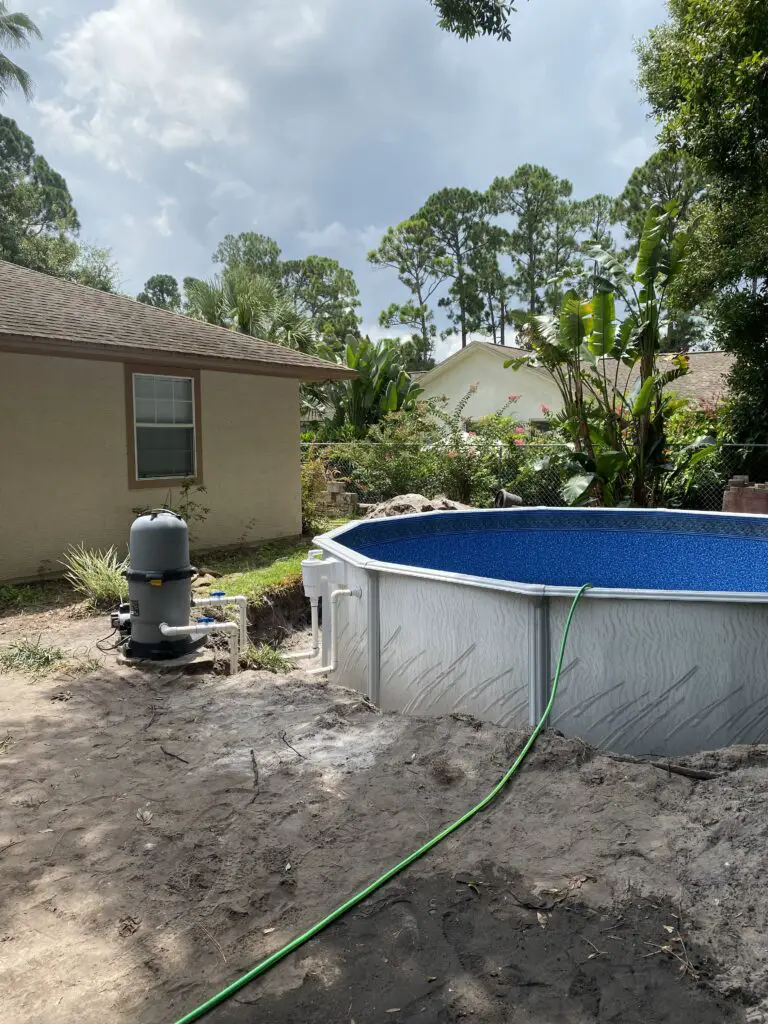
Most above ground pool packages come with a NON-self-priming pump. This means that the pump has to be placed below the water level of the pool when it’s done. If your pool is 2.5’ in the ground or more, the pump may be too high if you just set it on top of the ground and will not work.
Earlier this week, I dug an 18’ round in the ground. Their yard had an extreme slope to it, so on one side of the pool, it was in the ground only 21”. On the backside though, it was completely in the ground(54”). They wanted their pump and filter on the backside of the pool, so I had to notch out the earth and place them below the ground level. Later, they will have to build walls around it and create a pit, so they can service the pool’s equipment.
If you are in a situation where the pump will be lower than the pool’s water level, you can always get an inground (self-priming) pump. With those, you can place the pump and filter at any level you want. They cost a lot more though.
Some filters will sit much higher than the pool when going semi-inground. This will make them very visible which some don’t like. In this case, you could build an attractive dog house to cover it or move it away from the pool.
9. Going semi in the ground makes the pool nicer because it’s not as high
People decide to sink their pools down in the ground for a couple of reasons. One is to make it more accessible for elders or dogs, but the main reason is that they don’t want the pool to be as high off the ground.
It’s nice to have a deck built up high against an above ground pool so the water is at your feet. But if the pool is built on top of the ground, then the deck will be high and you won’t have as much privacy from your neighbors.
Pools that go partially in the ground can be well hidden when people build decks around them. A wood deck needs some elevation anyway since it has a support structure underneath the decking boards, so it can look like the pool isn’t in and ground at all.
Also, when at ground level in your backyard, it’s nicer to see the water of the pool. When an above ground is installed on top of the ground, you can only see the water at ground level when you are closer to it. And it can be easier to see the kids swimming from the inside of the house when the pool is semi in the ground.
10. Above ground pool manufacturers have some warranty restrictions with going semi in-ground
It’s very common for me to see new pool owners really want to sink their pool in the ground some, but choose not to because the manufacturer will void the pool’s warranty.
This is unfortunate because pools can get buried halfway in the ground due to the yard being off level and the manufacturers cover that with no problem. What I mean here is that when a pool gets installed in a yard that is off level by, say, two feet or more, then the high part of the yard has to be dug out to make the area level for the pool. When done, the pool will be two feet buried in the ground on one side and completely out of the ground on the other side. The warranty will cover the pool in that case.
As far as the parts of the pool go, there is no difference between a pool that is two feet done on just one side and a pool that is two feet down all the way around.
Some above-ground makers will have restrictions for going semi in the ground. They may allow for a certain maximum depth like twelve inches or eighteen inches down. I’m not going to list what certain manufacturers’ warranty rules are because they change or are different depending on who you ask or what you read.
Certain pool retailers may tell you something about warranty restrictions based on a conversation with the distributor or maker of the pool. And that information may not be accurate.
My opinion is to not worry about the manufacturer’s warranty. It’s not that good anyway. It only covers defects of the product. And just so you know, things like rust or fading or warping is almost always NOT considered a product defect and will not be covered by the manufacturer, whether the pool is in the ground or not.
11. Local code for sinking an above ground pool semi in-ground
In the United States, there are thousands of counties, cities, townships, and territories. A lot of these municipalities have their own building codes. And when it comes to above ground pools, they are all different and most change their rules and interpretations of their rules often.
This the government I’m talking about here. And their rules can make no sense and be interpreted in different ways. If you want to know if you can partially bury your above ground swimming pool, then either call or go down to your local building department and ask about it. You may get a different answer from different people working there, but that’s the best you can do to find out.
BONUS Future deck considerations
The majority of people who sink their pools in the ground have plans for adding a deck to it. Keep in mind that a wood deck requires some elevation in order to build it. This usually works well with pools that go in the ground about halfway (2’-2.5’). You’ll want to have the pool out of the ground enough for this.
And regardless of whether the pool is in the ground or not, always consider that during future liner changes, the top rails of the pool will have to come off (unless the pool has a bead channel). So, it’s never a good idea to run the deck boards over the pool’s top rails.
Instead, run the deck boards under the top rails. It’ll look better anyway because the end of the boards will be hidden and you won’t have to have a perfect endpoint of the deck.
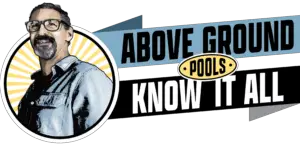
Make since too me!!
..I am in the planning stages & shopping for a pool i can recess partial or full. I hear of many brands but would like to know what you recommend??
Hercules dealer talks about a snap in liner?
My big concern is install. I am in ohio. This article is very informative. Thank you
Margie
Hi can I safely but river rock around my sunken above ground poop?
Thanks MikeA
Yes
Looking for some much appreciated expert advice: We decided to recess our 18×33 oval pool due to sloping issues in our yard here in Indiana. It is set up a few feet from our porch (long side running with length of porch). The other long side and oval ends will be back filled a few feet (about half way up pool) to be even with yard on that side. I am wondering if we can back fill (essentially bury) the side by the porch all the way up with dirt without issues with walls later, or is concrete fill recommended for this project?
With not knowing anything about your earth, my advice is to always do more when backfilling deeper than half-way(more than 2.5ft). In your case, I recommend reinforcing your backfill on the high side OR building a retaining wall for that side.
Hello, we just had a 30 ft. Pool installed. I will be working on backfill tomorrow when it is more than half full. I found your article very helpful, bu I have one question. How do you feel about a French drain being placed around the pool? 4-5 inches of dirt, French drain, and then finish backfill? Or French drain first then all the backfill? Pool is 26” in the ground on one side at most.
Hi. In most cases, a french drain is not at all needed. It depends on what region you live in. Here in Central Florida for example, there is no application for a semi above ground pool to have a french drain. A yard may need some water redirection around an above ground pool, but that’s not really related to the pool.
In the north where the ground freezes, thawes, and re-freezes, the ground can push things around if water is allowed to hanguot in certain areas. I don’t see full above ground pool walls being able to move much in this manner, but you never know. Who would know is a pool installer like me but local to you. He/she will know. Don’t believe just anyone though. The average installer doesn’t do this long enough to really learn things like this.
As far as the depth to set the drain goes, common sense would have me putting it (if I decided that I needed one) like your first description – 5 inch layer, then the drain, then backfill. Maybe a little higher depending on where you think the level of moisture may gather.
Thinking of installing a 24ft round pool 52 inches deep fully in ground,,,going to form around pool and do a concrete slurry wall 6 to 8 inches thick around it,,,going to back fill completely around outside of slurry wall with gravel,,,flexible drain under gravel all the way around pool,,would any decent above ground pool be acceptable to use if done like this ?? Your thoughts please!
Yes, any decent metal-walled above ground will be good for this. I recommend (as always) that you get a pool with a stainless steel service panel. And any pool with a stainless panel will be an upgraded model, which is good as that will ensure that it will be a good quality steel wall made in North America. Learn about stainless panels here: https://abovegroundpoolsknowitall.com/what-is-a-stainless-steel-service-panel-for-above-ground-pools/
Hi,
We’re considering fully recessing our metal walled above ground pool, by building a concrete block retaining wall on the inside of the hole. We have very sandy soil. Would that be acceptable?
Yes!! That is a solid and long lasting retaining wall for sure. I have seen them not built very well, somewhat failed, and still worked to keep enough earth from the pool wall for years.
Thank you for sharing your knowledge. I am installing a semi inground pool diy and I wanted to know your thoughts on using landscaping rocks around to pool walls…I have already cut into the earth and started assembling my pool frame.
Hi. Read this article and choose what you want. The pool being semi-inground won’t make any difference. https://abovegroundpoolsknowitall.com/what-people-typically-put-around-the-outside-of-their-above-ground-pool/
Hi II have a small cottage in St Augustine I have just a pool like an intel .I have considered having a hole dug and put a wall around in retaining blocks filled with concrete and use this taking the inexpensive pool out as it gets older . Will this work
Yes that will work nicely. Kind of an expensive option, but it will work for years.
Do you know a good above ground pool installer in Southern, IN – very close to Louisville, KY?
Also, I bought an 18’ x 52” round and I just want about a 1/3rd – 1/2 of it lower/partially in-ground, so the deck isn’t so high up off the ground; would like some privacy. I’m not putting a deck all the way around; we won’t have enough room for that because of my fence on the back & side of yard.
I would like your opinion about doing this.
Thank you.
Good installers are very rare in most areas. I only have the installers list https://abovegroundpoolsknowitall.com/nationwide-installer-list/ to help.
What you want to do with your yard is quite common. It comes out very nice when done.
Do you do install in Louisiana or recommend someone who can please
Sorry I don’t and do not. Here’s an article that may help you find someone https://abovegroundpoolsknowitall.com/9-ways-to-find-an-above-ground-pool-installer/
I’m in Louisiana as well. Did you find an installer?
Did who find an installer?
Are you still installing in central Florida? We are local and shopping
Go to centralfloridaabovegroundpools.com
Can a framed pool be partially buried on one side? My yard has about a 2.5 foot slope, and I’d like to bury my 20’ oval pool on one side. So, I’ll be digging a hole into the hill, then installing the pool and backfilling. One long side of the oval will be about 2’ above ground, and the other will be completely above ground. Is that doable? Or does the pool have to have metal walls? We’ll eventually resolve our pool with a nicer above ground model, but right now, we are working with what we have…
You can do it, but the problem is that soft-sided pools don’t last long. So replacing yours will require you digging out the high side every time you chanegout the pool.
Hi. I have installed a semi-inground pool to depth of about 30″ to 36″, max. per manufacturer is 36″.
I’m installing a deck on one side, and am concerned about any deck support blocks (surface, not sunken) close to the pool, as this would add effective stress to the sides of the pool. About how far out from the pool wall can one add the extra loading of a deck support?
thanks!
When building a deck, you typically have a row of supports along the outside edge of it, so it can be unavoidable to have supports next to the pool. You should be able to set your deck supports at least four inches away from the pool wall, which is far enough away to not affect the pool at all.
Do I need to install the butress supports when burying the pool 36″ and if so why??
You do not! If you don’t have buttresses though, then you will have to carefully backfill as the pool is filling. The earth will then be the only thing holding the straight sides of the pool’s wall in place, so backfilling while filling the pool is crucial.
Hi! My family is planning to do a self-install on a 12 x 24 Aquasport 52 pool. My husband and sons are very handy and have watched many helpful videos and read informative articles (including yours). Our concern is the drainage. We are thinking of putting the pool semi-inground to 18″, with decorative stone or porous ceramic tile surrounding the pool. Where does the water drain when the kids splash if the area around the pool is sealed by grout or other sealants, especiallyif it’s a large amount of water?
It drains into the earth or beyond any solid deck you have. Same with a large amount of water, just like torrential rainfall would.
The earth around a pool can be completely flooded and not affect the pool. The thing to be concerned with is erosion(water carrying earth away), which shouldn’t be an issue unless you were installing the pool into a hillside.
Hi! I need help! Nobody in my area is seeming to respond to me. We installed a 24’ round above ground. On one side it either needs to be partially buried into ground but I hear mixed reviews ( about 2 ft) or would you recommend a retaining wall? I wish I could post a pic! On the opposite side one of the walls has a small bulge on the bottom. That area sunk in the ground a bit ( maybe 1-2 inches) When the water truck came they had the hose in that are with so much water pressure. Is this something that I should worry about or do you think it will be fine ? Is there an email I could attach pictures to you to see ? I’m a new pool owner and clueless lol
At 24″ deep and on only one side, I don’t think you need a retaining wall. An area at the pool’s bottom sunk some is nothing to worry about (unless it’s caused by a leak)
I’m in south Louisiana just had oval pool installed 18’x33’x52” one side is 18” in the ground what should I use to back fill
Usually what came out of the ground can go back in
https://abovegroundpoolsknowitall.com/11-things-to-know-when-backfilling-an-above-ground-pool/
First time pool owner what is a good depth To sink a pool Without boarding the warranty for a legacy diamond star?
You will have to check with the retailer and manufacturer of that pool model. In most cases, they only want you going down about half way (2ft -2.5ft). And that is as deep as I recommend as well. This article covers some warranty info: https://abovegroundpoolsknowitall.com/the-truth-about-above-ground-pool-manufacturer-warranties/
Should I use some sort of coating or plastic vapor barrier on the outside of the walls that will be below ground level? My pool guy also recommended putting insulation panels down there before backfilling the areas that will be buried. Thoughts?
My thoughts are to not put anything except backfilling material. Anything that can trap moisture is a really bad idea.
Thank you very much for this
Extremely Imformative Article, I feel confident in having an above pool sunken in the ground!!